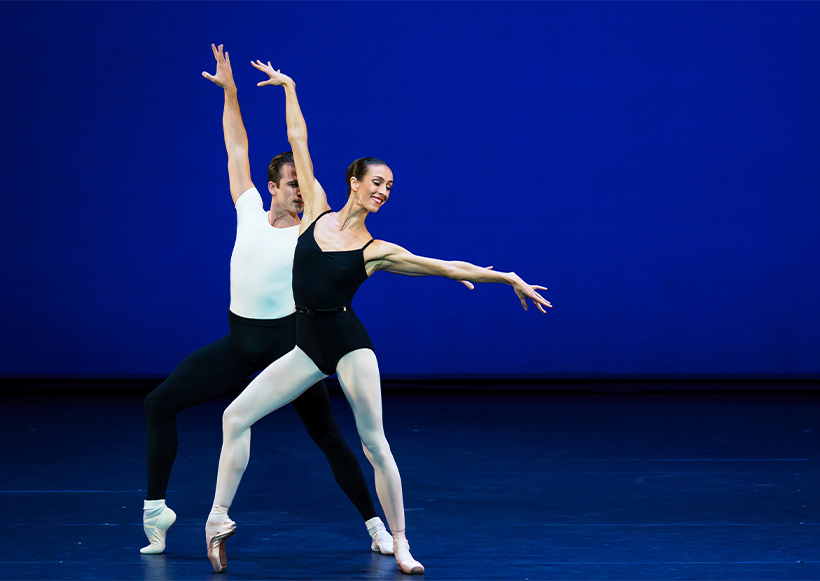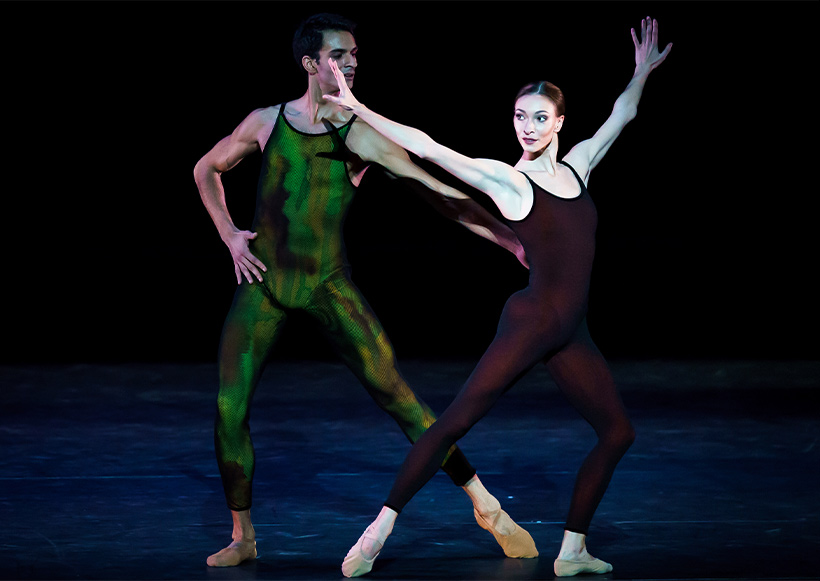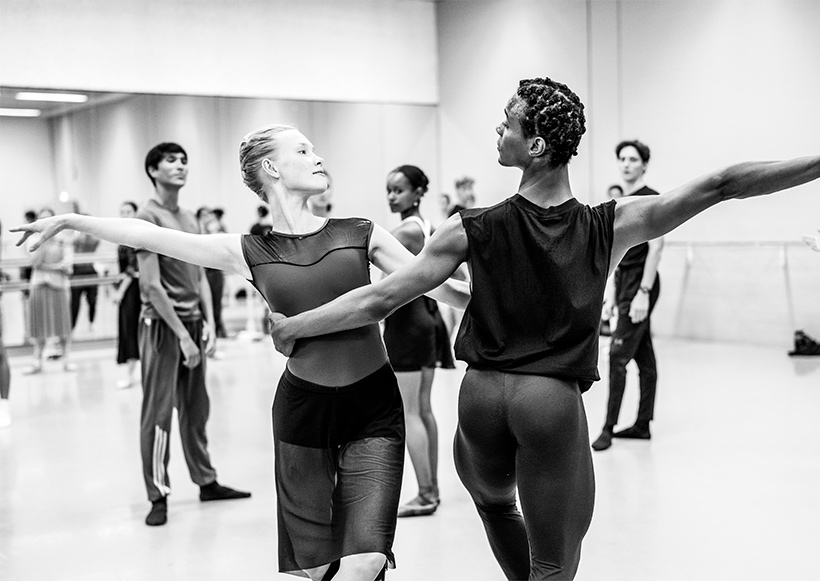
Music and dance in harmony: The music pieces in Four Temperaments
Since the fifteenth century, ballet music has grown from a simple accompaniment to complex compositions. The four ballets in Four Temperaments also attest to this evolution, whereby music and dance play equal roles.
The American-Russian choreographer George Balanchine (1904-1983) once spoke the famous and oft-repeated words: “See the music, hear the dance”. He thus expressed his vision of music as an essential part of the creation of a choreographic work. This view is also an extremely important aspect of the working process of the other three choreographers in the programme Four Temperaments: Hans van Manen, Ted Brandsen and Juanjo Arqués.
Harmonious character studies
The motto ‘See the music, hear the dance’ also formed the starting point for Balanchine’s groundbreaking The Four Temperaments. In 1940, he commissioned the German composer Paul Hindemith (1895-1963) to write around fifteen minutes of music – “something for piano that I can play at home”. However, Hindemith composed a piece lasting nearly thirty minutes, in which he explores the contrasting features and moods of the Ancient Greek temperaments at great length. The piece comprises five sections: one theme and four variations, whereby each variation corresponds to one temperament, in which Hindemith manipulates musical elements like time, rhythm and tempo to characterise the personality traits.

The first variation, associated with the melancholic temperament, opens with a dark rhythm that is reminiscent of a French Baroque overture. The dissonant piano is in stark contrast to the subdued, consonant violin. In the middle section of this piece, the strings and piano speed up and the tension increases, until it explodes in a slow, heavy march that is based on a sicilienne (originally an Italian folk dance that evolved into a music form). Hindemith uses alternating slow and quicker tempos, dissonance and a subtle interplay between strings and piano, in order to create a feeling of sadness and wistfulness. The melancholic variation is in complete contrast to the second, sanguinic variation, which opens with a cheerful, lively waltz with high-spirited melodies, and closes with a fiery statement, once again based on a sicilienne. The piece thus represents the lively, optimistic characteristics of a sanguine temperament.
The third, phlegmatic section starts off rather soporific and detached, although its measured tempo and calm rhythm also give a feeling of balance and stability. In direct opposition to this is the fourth and final variation. The choleric section begins with flaring passion, whereby the piano and strings vie to become the dominant part. The strings win in the middle section, but not without the piano questioning this conquest. The battle between the two instrument groups reflects the hot-headed character of a choleric temperament and is reinforced by the quick tempo and staccato playing.

Virtuoso variations
For Frank Bridge Variations, Hans van Manen also took inspiration from a composition of almost the same name: Variations on a Theme of Frank Bridge by Benjamin Britten (1913-1976). In this ballet, Van Manen demonstrates his skill in creating strong contrasts – just like the ones heard between the different variations in the music.
From 1927, Britten had lessons in composition from the British composer Frank Bridge (1879-1941), and Variations on a Theme of Frank Bridge is a musical tribute to his teacher. The theme Britten used as the basis for his variations comes from the second part of Bridge’s Three Idylls for String Quartet, which also explains the title of Britten’s composition. The introduction immediately demands the listener’s attention and briefly acquaints us with this ‘Theme of Frank Bridge’. It soon resolves into the Adagio, the first variation. The Adagio slows down the original theme, allowing the rich timbres of the string orchestra to be heard to the full. The development from the lively March in the second variation, via the dreamy, tender Romance, to the wild musical phrases in the following sections shows how Britten succeeds in composing a wonderful drama of musical contrasts from one single theme.
Compelling foxtrot
For the quadruple bill Four Temperaments, artistic director Ted Brandsen created a new ballet to the swinging piece of music The Chairman Dances by the American composer John Adams, which he originally wrote for his opera Nixon in China. The composition The Chairman Dances is lively and jazzy, reflecting the foxtrot dance style that gives the work its subtitle: ‘Foxtrot for Orchestra’. The piece has a mix of driving rhythms and a colourful orchestration, in which Adams’ characteristic minimalist style flourishes.
The piece opens with the rich, deep and warm timbres of the bassoons and violas playing the main theme, following which more instruments are gradually added to create a pulsating structure. The full orchestra then plays different rhythms, building up a busy sound that finally ebbs away again, so that only the piano and percussion instruments remain to play the chord scheme of the major theme. The composition alternates between 2/2 and 3/2 time, thus maintaining a steady, strong beat. This creates a tension that is kept up by the composition for the whole thirteen minutes. The Chairman Dances closes with a remarkable ending that symbolises a gramophone winding down: a nod to the third act of Nixon in China.

Turbulent soundscapes
For his new work Full Frontal, the young choreographer Juanjo Arqués used music by the contemporary composer Michael Gordon. Weather One, orchestrated for string sextet, breaks through the boundaries of both classical music and pop music. Gordon’s minimalist style is somewhat reminiscent of John Adams, but his compositions are not nearly as complex. He transforms subtle rhythms into incredibly powerful music that suggests a mix of punk rock, jazz and classical modernism.
Gordon’s conflicting, simultaneous rhythms create forceful, energetic music. His Weather One – the first section of the four-part work Weather – is inspired by chaotic weather patterns. The way in which Gordon has written the parts for the strings creates a hypnotic and meditative listening experience. Strongly inspired by Vivaldi’s motoric way of composing for strings, Gordon has written a work that is continually in motion and driving forwards.
Each composition in Four Temperaments represents a multi-layered work to which the dance does full justice. From classical masterpieces to innovative contemporary works, the four composers have succeeded in inspiring choreographers to enter into the dialogue between music and dance.
Text: Stan Schreurs
- Four Temperaments will be performed at Dutch National Ballet from 16 September to 30 September 2023